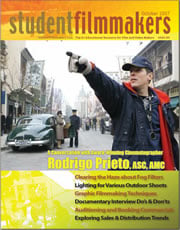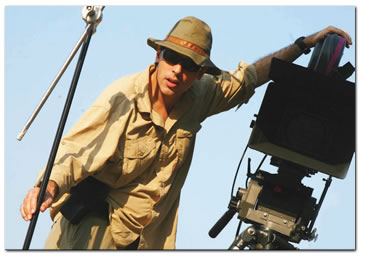HOW-TO, Techniques, & Best Practices Channel
| A Conversation with Award-Winning Cinematographer Rodrigo Prieto, ASC, AMC By Staff posted Nov 8, 2009, 07:07 |
Check out this article in the print edition of StudentFilmmakers Magazine, October 2007. Click here to get a copy and to subscribe >>
 A Conversation with Award-Winning Cinematographer Rodrigo Prieto, ASC, AMC
A Conversation with Award-Winning Cinematographer Rodrigo Prieto, ASC, AMC
by Jacqueline B. Frost
| Continued on Next Page> | Page 1 | 2 | 3 | 4 |
Rodrigo is one of the hottest cinematographers working in the industry today. Nominated for an Academy Award for the beautiful cinematography in Ang Lee�s �Brokeback Mountain� (2005), he is also the cinematographer of Ang Lee�s film, �Lust, Caution,� (2007). He has collaborated with Alejandro Inarritu on �Babel� (2006), �21 Grams� (2003), and �Amores Perros� (2000). He was the Director of Photography on Oliver Stones epic, �Alexander� (2004) and �25th Hour� (2002) for Spike Lee. He shot �Frida� (2002) for Julie Taymor and �8 Mile� (2002) for Curtis Hanson. Although �Original Sin,� (with Director Michael Cristofer, 2001) was Rodrigo�s first big, American film, his list of credits in Mexico is extensive. I met with Rodrigo in Brentwood to talk about his work as a cinematographer with some of Hollywood�s biggest names in directing.

Rodrigo Prieto, ASC, AMC
Could you talk about the collaborative relationship between the director and cinematographer? What is the ideal situation for you? How do you like to work with a director?
Rodrigo Prieto, ASC, AMC: One of the things I like about what I do is precisely the collaboration with the director, and the opportunity to work with people who I find their point of view [how they see things] interesting, and to work with someone who would approach things completely differently than I would. I find that it helps me grow when I get involved with someone else�s point of view. And I have to learn to listen and see why a director would go in a path that would not have been my first instinct. But, then discovering what it is about that path that I can work on, it helps me to grow, and sometimes it�s painful. It can be difficult to find your way in a certain new perspective.
Ideally, I try to get myself in tune with the director�s point of view. And what I enjoy is then coming back with a set of ideas that conform to that basic structure or groundwork and bring something additional to the plate.
What is your process for preparing for a film?
Rodrigo Prieto, ASC, AMC: My process is, I of course, first read the script, and from there, ideas are generated, but I try not to fall in love with my ideas � just get some basic concepts. I try to listen first to what the director has to say, maybe talk about some of the concepts I had on my first read. Then once I understand the approach to what the director is trying to do, then I go to my photography books or visual references and try to come up with visual ideas that I can present to the director. Maybe a certain scene could have a certain type of framing or grain structure or color. And I present these ideas to the director so we can ping pong ideas back and forth, discard some, keep some � and that will evolve during preproduction. For me, that�s very enjoyable, and that�s exactly the process I�m in right now with the current movie. I�m doing investigation, and then, of course, the production designer and research will come into play as well. So it�s a three-part collaboration. I try to be involved in all of it with the Director and Production Designer.
Of course, the ideas are all based on the director�s original intention, but we all try to come up with ideas that will work together. It�s a whole process that�s really enjoyable and for me. Prep is like going to film school all over again. I try to keep an open mind and test, test, test everything that I am imagining. I always try to test things I haven�t done before, not for the sake of doing something different but to explore different avenues and to see what we can get. Then, I present these ideas and tests to the director, and from there, we narrow it down to what will be the movie.
What if a director comes to you with the storyboards all prepared and says, �I want it like that�?
Rodrigo Prieto, ASC, AMC: That happened to me only once on a movie in Mexico, and I actually tried to quit. Even while scouting locations, any proposal I had about camera placement or framing would immediately be shot down because everything had to be exactly how the director planned it on the storyboard, so there was no room for anything. So I said, �what do you want me for, find someone else.� But then he said, but you can do whatever you like with lighting, but this is what I want with camera angles and framing. So I decided to go for it and told myself I would learn to work like this, and it was a good experience for me in the end. I try not to set myself into a definite way of working because every director is different, so I try to be flexible and work in different ways.
That movie many years ago helped me to work with Ang (Lee). He doesn�t do shot lists or pre-storyboarding. It comes up in the set after rehearsal, and he�ll stand there and contemplate. He�ll ask for the directors finder with a specific lens, and he�ll set the angle and framing, and that for me is different than what I had done with other directors. It wasn�t easy for me when we started �Brokeback Mountain,� but I got used to it. Ang has very good taste in terms of framing and choice of lenses, and it always makes sense to me. Because the choices he makes are correct. It doesn�t hurt me because it�s not a thing about �ego, he picked it, so then I�m upset�. No � he�s right, it�s a good angle and a good lens, and I have no problem with that. You only have a problem when it doesn�t feel right. When you know that choices could work better another way. But most of the time, the differences between what he�ll pick and what I would have done have to do with camera height. Ang always wants the camera to be the eye level of the actor, no matter what. I find that�s not always the best angle. It�s almost like a mantra, it�s the way it is. Sometimes I would have to really talk him into the slightest adjustment. I certainly do find Ang�s approach very much organic with the material. The choices have to do with the characters and the story, and they are very subjective and I like it. I enjoy working with him, although it is not the kind of collaboration I have with Alejandro, or Oliver Stone or Curtis Hanson.
right, it�s a good angle and a good lens, and I have no problem with that. You only have a problem when it doesn�t feel right. When you know that choices could work better another way. But most of the time, the differences between what he�ll pick and what I would have done have to do with camera height. Ang always wants the camera to be the eye level of the actor, no matter what. I find that�s not always the best angle. It�s almost like a mantra, it�s the way it is. Sometimes I would have to really talk him into the slightest adjustment. I certainly do find Ang�s approach very much organic with the material. The choices have to do with the characters and the story, and they are very subjective and I like it. I enjoy working with him, although it is not the kind of collaboration I have with Alejandro, or Oliver Stone or Curtis Hanson.
With Alejandro (Inarritu), we shotlist together, sometimes storyboard. I can draw a little bit, so sometimes I�ll do some storyboarding. At times we�ve hired storyboard artists, but we do sit down in preproduction. And I really like the process, even if we don�t use it during production because it gets us talking very specifically about the scene and what type of lenses, why would we start with a detail or a long shot, why? Why are we doing things, of course, we use our intuition when we are shotlisting, but it really gives a sense to the way each scene is covered and helps very much in editing. Alejandro has a really good sense of editing and sound, so in storyboarding we also talk about how it�s going to cut together. We shotlist as if we are editing, we even makes sounds, or do music. So it�s a very enjoyable process. And on the set, we have a blue print, whether we chose to use it or lose it.
| Continued on Next Page> | Page 1 | 2 | 3 | 4 |